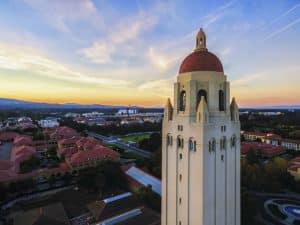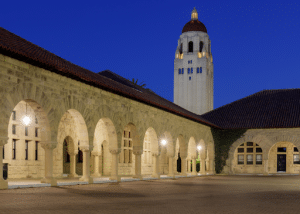Stanford Graduate School
Stanford University is renowned for its prestigious graduate programs and esteemed faculty. As one of the top-ranked institutions in the world, it attracts students from all corners seeking advanced education and intellectual growth. If you are considering applying to Stanford Graduate School, this comprehensive guide will provide valuable insights into the application process, academic requirements, and tips to help you craft a compelling personal statement.
Understanding Stanford Graduate School
Stanford University holds immense prestige in the academic world. With a rich history and exceptional reputation, it consistently ranks among the top universities globally. Its graduate programs are known for their rigorous curriculum, cutting-edge research, and emphasis on interdisciplinary learning. Whether you are interested in pursuing a Master’s or Ph.D. degree, Stanford offers a diverse range of programs across various disciplines.
The Prestige of Stanford
Stanford’s reputation derives from its commitment to excellence in teaching, research, and innovation. Its faculty members are experts in their fields, often leading groundbreaking research and making significant contributions to their respective disciplines. The university’s strong network of alumni also includes numerous influential figures, showcasing the impact of a Stanford education on society.
Stanford’s commitment to excellence is evident in its state-of-the-art facilities and resources. The university invests heavily in providing students with access to cutting-edge technology, research labs, and libraries. This commitment ensures that students have the necessary tools and resources to excel in their academic pursuits.
Moreover, Stanford’s location in the heart of Silicon Valley offers unique opportunities for collaboration and innovation. The university has strong ties with industry leaders and startups, providing students with valuable networking and internship opportunities. This vibrant ecosystem fosters an entrepreneurial spirit and encourages students to think outside the box.
The Variety of Programs Offered
Stanford Graduate School offers a wide array of programs across multiple fields of study. From business and engineering to humanities and sciences, you can find a program that aligns with your academic and career goals. Research each program thoroughly to identify the one that best suits your interests and aspirations.
For those interested in business, Stanford Graduate School of Business is renowned for its innovative curriculum and emphasis on leadership development. The program offers a range of specializations, including finance, marketing, and entrepreneurship, preparing students for success in the dynamic business world.
If you have a passion for engineering, Stanford’s School of Engineering is a top choice. With its cutting-edge research facilities and renowned faculty, the program equips students with the skills and knowledge needed to tackle complex engineering challenges. From computer science to biomedical engineering, the School of Engineering offers a diverse range of disciplines to explore.
For those with an interest in the humanities and social sciences, Stanford’s School of Humanities and Sciences provides a comprehensive education that fosters critical thinking and intellectual exploration. The program offers a wide range of disciplines, including history, philosophy, psychology, and sociology, allowing students to delve deep into their areas of interest.
Stanford Graduate School also offers programs in the natural sciences, including biology, chemistry, physics, and environmental science. With state-of-the-art research facilities and renowned faculty, students have the opportunity to engage in groundbreaking research and contribute to scientific advancements.
Regardless of the program you choose, Stanford Graduate School provides a supportive and collaborative environment. The university values diversity and encourages students to engage in meaningful discussions and debates. The vibrant campus community offers numerous extracurricular activities, clubs, and organizations, allowing students to pursue their interests outside of the classroom.
Preparing for Your Application
Before diving into the application process, it is essential to understand the requirements and expectations set by Stanford University. While the admission process can be competitive, proper preparation can significantly enhance your chances of acceptance.
When preparing your application for Stanford University, it is important to consider all aspects of the admissions process. From academic requirements to extracurricular and leadership qualities, each component plays a crucial role in determining your suitability for admission.
Academic Requirements
Stanford Graduate School seeks applicants who demonstrate exceptional academic abilities. It is crucial to maintain a strong undergraduate record, with a focus on relevant coursework that aligns with your desired field of study.
When it comes to academic requirements, Stanford University looks for candidates who have excelled in their undergraduate studies. This means not only maintaining a high GPA but also taking challenging courses that are directly related to your intended field of study. By demonstrating your academic prowess in these areas, you can showcase your ability to thrive in Stanford’s rigorous academic environment.
In addition to your undergraduate record, standardized test scores, such as the GRE or GMAT, may be required for certain programs. These scores provide an additional measure of your academic aptitude and help the admissions committee assess your readiness for graduate-level coursework. It is important to research each program’s specific requirements to ensure you meet the necessary academic benchmarks.
Extracurricular and Leadership Qualities
Stanford values well-rounded individuals who have actively participated in extracurricular activities and demonstrated leadership potential. While academic achievements are important, Stanford also wants to see that you have engaged in activities outside of the classroom.
When considering your extracurricular involvements, think about activities that showcase your interests, passions, and commitment to making a positive impact on your community. This could include involvement in clubs, volunteer work, or leadership roles within your academic or professional spheres.
By actively participating in extracurricular activities, you not only demonstrate your ability to manage your time effectively but also show your dedication to personal growth and community engagement. These qualities align with Stanford’s mission of producing graduates who will make a positive difference in the world.
Furthermore, leadership potential is highly valued by Stanford University. Whether it is leading a student organization, spearheading a community service project, or taking on a leadership role in your workplace, showcasing your ability to inspire and guide others can greatly enhance your application.
Overall, preparing for your application to Stanford University requires careful consideration of both academic requirements and extracurricular and leadership qualities. By focusing on these areas and putting in the necessary effort, you can increase your chances of being accepted into this prestigious institution.
The Application Process
Once you have familiarized yourself with the requirements and gathered the necessary documents, it is time to navigate the application process. It is essential to plan your timeline carefully to ensure you submit a strong and complete application.
Applying to Stanford Graduate School is an exciting and challenging endeavor. The application process is designed to assess your qualifications, experiences, and potential to contribute to the academic community. As you embark on this journey, it is important to be well-prepared and organized.
The Timeline for Application
Stanford Graduate School operates on a rolling admissions process, with different programs having varying deadlines. It is crucial to familiarize yourself with each program’s specific deadlines and prepare your application well in advance. Be mindful of the time required for standardized test preparation, obtaining recommendation letters, and crafting your personal statement.
Creating a timeline for your application can help you stay on track and ensure that you meet all the necessary deadlines. Start by identifying the key milestones, such as the submission deadline, test dates, and when you need to request recommendation letters. Then, work backward to determine when you should start preparing for each step. This will give you a clear roadmap and help you allocate your time effectively.
Required Documents for Application
Along with your completed application form, you will need to provide additional documentation. This typically includes official transcripts, standardized test scores, letters of recommendation, and, in some cases, a resume or curriculum vitae. Ensure you thoroughly review the specific requirements for each program to avoid any omissions or mistakes in your application.
Official transcripts are an essential component of your application. They provide an overview of your academic performance and demonstrate your ability to excel in a rigorous academic environment. Make sure to request your transcripts well in advance to allow for any processing time.
Standardized test scores, such as the GRE or GMAT, are often required for graduate school applications. These scores provide a standardized measure of your academic abilities and can help admissions committees evaluate your potential for success in their program. It is important to allocate sufficient time for test preparation and to take the exam early enough to meet the application deadline.
Letters of recommendation play a crucial role in the application process. They provide insights into your character, abilities, and potential as a graduate student. When selecting recommenders, choose individuals who know you well and can speak to your academic and professional capabilities. It is advisable to reach out to your recommenders early on and provide them with all the necessary information and deadlines.
In some cases, a resume or curriculum vitae may be required as part of your application. This document provides an overview of your educational background, work experience, research projects, publications, and other relevant achievements. Take the time to update and tailor your resume to highlight your most significant accomplishments and experiences.
By carefully reviewing and understanding the required documents for your application, you can ensure that you submit a complete and well-prepared package. Pay attention to any specific formatting guidelines or additional materials that may be requested by the program.
Writing a Compelling Personal Statement
The personal statement is a crucial part of your application, allowing you to showcase your uniqueness and articulate your motivations for pursuing a graduate degree at Stanford. Pay attention to the following guidelines to craft a compelling personal statement.
When writing your personal statement, it is important to remember that Stanford values individuals who exhibit intellectual curiosity, passion for their chosen field, and the ability to contribute meaningfully to the campus community. Your personal statement should reflect these qualities, highlighting your academic and professional experiences and explaining why Stanford is the ideal place for your further education.
What Stanford Looks for in a Personal Statement
Stanford University is renowned for its commitment to academic excellence and its vibrant campus community. When reviewing personal statements, the admissions committee looks for applicants who not only possess exceptional academic achievements but also demonstrate a genuine passion for their chosen field of study.
Stanford values individuals who are intellectually curious and have a thirst for knowledge. They seek students who are not afraid to ask questions, challenge conventional wisdom, and explore new ideas. The personal statement is an opportunity for you to showcase your intellectual curiosity and highlight the experiences that have shaped your academic journey.
Furthermore, Stanford is interested in applicants who have a clear sense of purpose and a strong motivation to make a difference in their chosen field. They want to see evidence of your commitment to your academic and career goals and how a graduate education from Stanford will enable you to achieve them.
Lastly, Stanford is a community that thrives on diversity and collaboration. They seek individuals who can contribute meaningfully to the campus community and engage in interdisciplinary dialogue. Your personal statement should demonstrate your ability to work well with others, your leadership potential, and your commitment to making a positive impact on society.
Tips for Crafting Your Personal Statement
Writing a compelling personal statement takes time and effort. Here are some tips to help you craft a personal statement that stands out:
1. Start early: Give yourself plenty of time to reflect on your journey and the experiences that have shaped your aspirations. Starting early will allow you to brainstorm ideas, gather supporting evidence, and revise your statement multiple times.
2. Be authentic: Your personal statement should reflect who you are as an individual. Be genuine in sharing your story, focusing on your unique strengths, perspectives, and experiences. Avoid using clichés or trying to write what you think the admissions committee wants to hear.
3. Clearly articulate your goals: Clearly state your academic and career goals and explain how a graduate education from Stanford will help you achieve them. Show the admissions committee that you have a clear vision for your future and that Stanford is the perfect place to turn that vision into reality.
4. Revise and edit: After completing your first draft, take the time to revise and edit your personal statement. Ensure that your ideas flow logically, your writing is clear and concise, and your grammar and punctuation are impeccable. Consider seeking feedback from professors, mentors, or friends to gain different perspectives and improve your statement.
Remember, your personal statement is an opportunity to showcase your uniqueness and convince the admissions committee that you are a perfect fit for Stanford. Take the time to craft a compelling personal statement that highlights your strengths, motivations, and aspirations. Good luck!
Securing Strong Letters of Recommendation
Letters of recommendation provide valuable insights into your abilities and potential as a graduate student. Thoughtful consideration in choosing your recommenders and crafting a compelling request can significantly impact the quality of these letters.
Who to Ask for a Letter of Recommendation
Select individuals who know you well and can speak to your academic abilities and personal qualities. Professors, research advisors, or mentors who have worked closely with you are ideal choices. Moreover, ensure that your recommenders can provide specific and detailed examples of your achievements and potential.
How to Request a Letter of Recommendation
Approach your potential recommenders early in the application process, providing them with ample time to write a strong letter on your behalf. Schedule a meeting or send a formal request, explaining why you believe their perspective and insights will be valuable to the admissions committee. Provide any necessary materials, such as your resume or personal statement, to help them craft a comprehensive letter.
By following this comprehensive guide, you will enhance your chances of a successful application to Stanford Graduate School. Understanding the prestige of Stanford, preparing diligently, and crafting compelling documents will set you on the path to a transformative graduate experience at one of the world’s most renowned institutions.
How AdmissionSight Can Help You With College Admissions
AdmissionSight is a college consulting firm that provides personalized assistance to students throughout the college admissions process. Here are some ways that AdmissionSight can help you:
Admissions strategy: AdmissionSight can help you develop a strategic plan for your college application process. Our professional consultants can assist with identifying schools that are a good fit for your academic, extracurricular, and personal goals and help you plan and prioritize your application strategy.
Application review: AdmissionSight can review your application and provide feedback on how to improve it. We can offer suggestions on making your application stand out and highlighting your strengths and unique qualities.
Essay coaching: AdmissionSight can help you craft compelling essays that showcase your personality, goals, and achievements. We can guide you through the essay writing process and provide feedback on your drafts to help you refine your writing.
Interview preparation: AdmissionSight can provide interview coaching to help you feel confident and prepared for college interviews. Our experts can offer tips on how to present yourself professionally and how to answer common interview questions.
Extracurricular planning: AdmissionSight can help you plan and develop your extracurricular activities to make them more impactful and meaningful. We can suggest activities that align with your interests and goals and provide guidance on demonstrating your leadership and initiative.
Overall, AdmissionSight can provide valuable guidance and support throughout the college admissions process to help you maximize your chances of getting accepted into the college of your choice.
With a high success rate of over 75%, we have built a strong network in the past decade. Book an initial consultation today, free of charge!










































